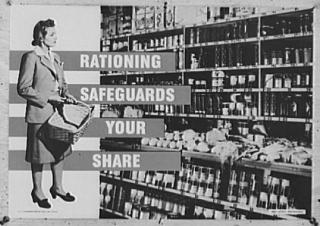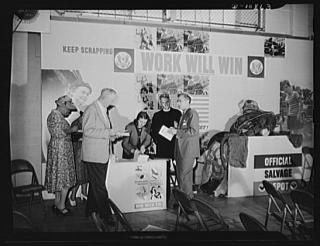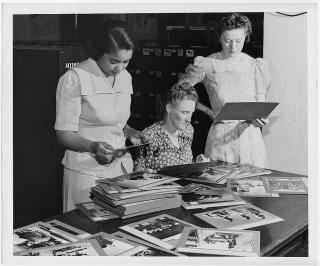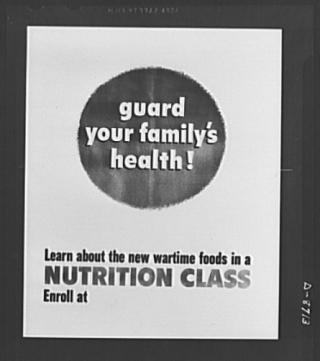Propaganda

Office of War Information Poster
Propaganda was an important part of helping America wage war in the 1940s. The US government, non-governmental organizations, and manufacturing companies each produced propaganda, which attempted to shape people’s activities at home and abroad.
As part of it efforts to combat fascism, distribute propaganda abroad and gather intelligence, the US government set up the Office of Strategic Services in June 1942. The organization was the forerunner to the Central Intelligence Agency (CIA). Employing both men and women, the OSS operated all over the world. At its peak in 1944, 13,000 people were working for the organization.
In June 1942, President Franklin Roosevelt signed Executive Order 9182, and the Office of War Information (OWI) was created. This branch of the federal government was tasked with providing Americans and people living abroad with information about the war. The public was suspicious of the term “propaganda” as it implied untruths. The OWI needed to carefully inform and educate the public about the war, without giving false or misleading information.
Elmer Davis, a CBS newsman, was asked to run the OWI. The organization was divided into different bureaus which worked in all types of media to produce information for the war effort. These bureaus included: the Radio Bureau, the News Bureau, the Bureau of Motion Pictures, and the Foreign News Bureau.

Office of War exhibit at American University
The Bureau of Motion Pictures worked with the film industry in Hollywood to make movies and short films that highlighted America’s war efforts. The Walt Disney film studio played a particularly prominent role in producing propaganda. During the war, approximately 90% of the films made by Disney were produced for the US military. Many of these were training films for the military. Other short animated films were shown to civilian audiences such as Private Pluto, Commando Duck and Der Fuehrer's Face, which featured Pluto and Donald Duck, and emphasized themes of patriotism, freedom, and democracy.
Non-profit and non-governmental organizations also produced propaganda for the American home front. The most important of these groups was the Writers’ War Board. Created in January 1942, the Board sought to promote US war aims and government policies. Although the OWI could not produce material considered to be “propaganda”, the Writers’ War Board was under no such restriction. It was eager to help the OWI by producing a wide variety of propaganda.

Fredrycka Weaver, Rachel Paczkowzki, and Katryna Lee Kritzer examining OWI photographs
The OWI was chaired by Rex Stout, a best-selling fiction author. The Board produced propaganda materials for every form of media including: radio, newspapers, magazines, and comic books. Authors were not paid for their activities, but worked as volunteers. These writers were often well-known and included historians, journalists, and novelists. Many of the contributors to the Writers’ War Board’s activities were famous women writers and academics including Margaret Leech, Katharine Seymour, and Pearl S. Buck.
Although the Writers’ War Board was a non-profit organization, it received some federal funding. The US government provided office space and supported the Board by paying the salaries of a small office staff. In turn, it is estimated that 85% of the Writers’ War Board propaganda was produced for the government.

Poster distributed by OWI to Office of Civilian Defense councils
American manufacturing companies also created their own in-house propaganda to encourage their workforce and boost production. Westinghouse Corporation, a large manufacturing firm, produced its own wartime propaganda to motivate employees. One of the men hired to create its propaganda materials was advertising agent, J. Howard Miller. During the war, Miller produced eleven posters for the Westinghouse Corporation to be displayed within their factories. Each poster was shown for approximately two weeks at a time. One of Miller’s posters was the February 1943 poster, “We Can Do It!,” representing Rosie the Riveter. This poster was produced and displayed only to factory workers at the Westinghouse Corporation. While the poster was little known outside of the factories during the war, today, it has become a popular poster linked with World War II.
By Dr. Kelly A. Spring
2017
Discussion Questions:
-
Who produced propaganda in America during wartime?
-
What role did the Office of War Information play during World War II?
-
How did the Writers’ War Board help the Office of War Information?
-
What sort of activities did the Writers’ War Board undertake during the war?
-
How did Hollywood help with wartime propaganda?
-
How did Disney support propaganda activities for the war effort?
Works Cited:
Articles
- Clayton R. Koppes and Gregory D. Black. “What to Show the World: The Office of War Information and Hollywood, 1942-1945.” The Journal of American History, 64 (1977): 87-105.
- Howell, Thomas. “The Writers’ War Board: US Domestic Propaganda in World War II.” The Historian, 59 (1997): 795-813.
- Kimble, James J. and Lester C. Olson. “Visual Rhetoric Representing Rosie the Riveter: Myth and Misconception in J. Howard Miller’s ‘We Can Do It!’ Poster.” Rhetoric and Public Affairs, 9 (2006): 533-569.
- Audio Recording
- Brand, Madeleine and Charles Solomon. “Disney's WWII Propaganda and Training Films.” National Public Radio, May 31, 2004. Accessed July 29, 2017. http://www.npr.org/templates/story/story.php?storyId=1917088
Films
- Commando Duck. Directed by Jack King. Walt Disney Productions, 1944.
- Der Fuehrer's Face. Directed by Jack Kinney. Walt Disney Productions, 1943.
- Private Pluto. Directed by Clyde Geronimi. Walt Disney Productions, 1943.
- Walt Disney Treasures - On the Front Lines. Directed by Sharpsteen, Ben, Justice, Bill, Roberts, Bill, Geronimi, Clyde and Ford Beebe. 1941-1943. Burbank, CA: Walt Disney Video, 2004. DVD
Thesis
- Howell, Robert Thomas. “The Writers' War Board: Writers and World War II.” PhD diss., Louisiana State University and Agricultural & Mechanical College, 1971.
- Website
- Central Intelligence Agency. “What was OSS?” Accessed August 28, 2017. https://www.cia.gov/library/publications/intelligence-history/oss/art03.htm
Additional Resources:
Article
- Harrington, Sarah. “Women’s Work: Domestic Labor in American World War II Posters.” The University of Chicago Press on behalf of the Art Libraries Society of North America, 22 (2003): 41-44.
Books
- Baxter, John. Disney During World War II: How the Walt Disney Studio Contributed to Victory in the War. Glendale: Disney Editions, 2014.
- Hooper, Roy. When the Stars Went to War: Hollywood and World War II. New York: Random House, 1995.
- Nelson, Derek. Posters that Won the War: The Production, Recruitment and War Bond Posters of WWII. Redundo: Crestline Publishing, 2015.
